Dive into the enigmatic world of Norman Mailer’s “Tough Guys Don’T Dance,” a film that continues to intrigue and divide audiences decades after its release. This in-depth analysis, inspired by a conversation between film critic Jonathan Rosenbaum and Justin Bozung, explores why this movie, often overlooked or misunderstood, deserves a second look as a unique and daring piece of cinema. We delve into its black comedy heart, its connection to Cannon Films’ offbeat productions, and its surprising links to David Lynch’s “Blue Velvet,” all while celebrating the film’s audacious spirit and challenging genre conventions.
Unveiling the Enigma: Why “Tough Guys Don’t Dance” Resonates with Cult Film Aficionados
“Why in the hell are you and I the only two people in the world that love this film?” This opening question encapsulates the cult status of “Tough Guys Don’t Dance.” While not a mainstream favorite, it has garnered a dedicated following, including critics like Rosenbaum and filmmaker Mark Rappaport, who recognize its unique cinematic qualities. Rosenbaum, admitting his general lack of enthusiasm for Mailer’s previous directorial efforts, makes a crucial distinction: “Tough Guys Don’t Dance” is a movie. Unlike Mailer’s earlier, more experimental works, this film possesses a Hollywood-esque structure and flair, hinting at what could have been had Mailer directed “An American Dream,” a novel thematically linked to “Tough Guys.”
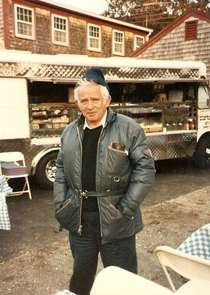 Norman Mailer in Provincetown
Norman Mailer in Provincetown
However, Rosenbaum also confesses his dislike for the “Tough Guys Don’t Dance” novel, calling it Mailer’s “worst book.” This stark contrast between the source material and the film highlights Mailer’s unexpected strength in cinematic adaptation. He manages to transform a “tiresome and sluggish potboiler” into something visually and narratively compelling, proving his aptitude for filmmaking, even if the source material was weak.
Black Comedy and Delirious Edges: Defining Mailer’s Unique Style
Mailer’s writing often thrives on the edge of “delirium,” where absurdity and brilliance intertwine. While “Ancient Evenings” exemplifies this style, “The Executioner’s Song” stands as a notable exception. This duality is crucial to understanding “Tough Guys Don’t Dance.” Mailer himself, in the film’s making-of documentary, acknowledges a “disastrous mistake”: Ryan O’Neal’s exaggerated “God, man, God, man” scene. Mailer’s self-awareness of this excess, and his inability to label the film a black comedy, points towards a potential misjudgment in his own work. The film’s humor, though dark and often missed, is undeniably present.
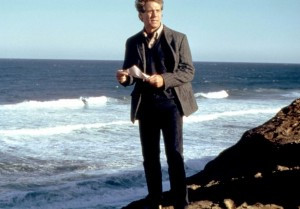 Seascape scene from Tough Guys Don't Dance
Seascape scene from Tough Guys Don't Dance
“Tough Guys Don’t Dance” finds kinship with Cannon Films’ stable of “excessive” films from the same era. These films, often hyperbolically personal, are almost “home movies” on a grand scale. Mailer filmed extensively in his own house, mirroring John Cassavetes’ approach in “Love Streams” (1985). This personal touch, also evident in Jean-Luc Godard’s “King Lear” (1987) and Raúl Ruiz’s “Treasure Island” (1985), adds a layer of raw, unfiltered creativity to “Tough Guys Don’t Dance,” contributing to its unique and somewhat unsettling atmosphere.
Genre Bending and Baroque Excess: Deconstructing the Film’s Unconventional Narrative
Mailer labels “Tough Guys Don’t Dance” a horror movie and a murder mystery, yet conspicuously avoids the term “comedy.” However, the film’s comedic elements are undeniable, especially in its later parts. The mocking use of “Pomp and Circumstance” during a corpse disposal scene, or Madeline’s off-screen shooting of Regency with the line, “Never call an Italian small potatoes,” are clear indicators of its black comedy DNA. The film culminates in “hysterical laughter,” leaving the audience in a state of bewildered amusement. This “hyperbole and excess” is precisely what flummoxes many viewers, contributing to its divisive reception.
 Scene from King Lear featuring Jean-Luc Godard and Peter Sellers
Scene from King Lear featuring Jean-Luc Godard and Peter Sellers
Rosenbaum initially likened the film to a Russ Meyer movie, but with “big egos” instead of “big breasts.” While retracting part of that statement, he acknowledges the “baroque” nature of both Meyer’s and Mailer’s works. This baroque quality, a sense of stylistic exaggeration and dramatic intensity, is a key element in understanding the film’s aesthetic.
Echoes of Blue Velvet: A Surprising Cinematic Parallel
Interestingly, Mailer admitted to liking and referencing David Lynch’s “Blue Velvet” (1986) in “Tough Guys Don’t Dance.” Both films share Angelo Badalamenti’s music and Isabella Rossellini’s presence, creating an uncanny resemblance. Thematic parallels also emerge, with strokes afflicting characters in both narratives. However, Rosenbaum argues for the superiority of “Tough Guys Don’t Dance,” citing Lynch’s “extreme puritanism” as a limiting factor. While Mailer also has a puritanical streak, his “desire to be disreputable” pushes boundaries further than Lynch’s more moralistic approach.
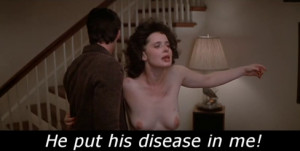 Scene with Isabella Rossellini and Ryan O'Neal from Tough Guys Don't Dance
Scene with Isabella Rossellini and Ryan O'Neal from Tough Guys Don't Dance
“Blue Velvet” operates on a premise of corrupted innocence, while “Tough Guys Don’t Dance” plunges into a world where “everyone is already corrupt from the get-go.” This cynicism, though arguably clichéd, resonates more potently for Rosenbaum. Mailer’s world, seen through a lens of “ten-year-old boy” perception of corruption, is devoid of naiveté, making “Tough Guys Don’t Dance” a more palatable, albeit darker, cinematic experience than “Blue Velvet”‘s exploration of innocence lost.
Shakespearean Dialogue and Oneiric Qualities: Deepening the Analysis
The dialogue in “Tough Guys Don’t Dance,” much like in Mailer’s “An American Dream,” is described as “almost Shakespearean.” Every line is stylized, performative, and deliberately “movie-like,” avoiding clichés. This heightened language contributes to the film’s dreamlike quality, further emphasized by Mailer’s own statement that films should be “spooky, dream-like, and visceral.”
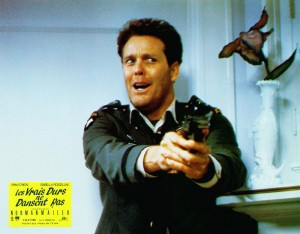 Wings Hauser in Tough Guys Don't Dance
Wings Hauser in Tough Guys Don't Dance
The film’s structure and narrative also contribute to its oneiric nature. Flashbacks are disorienting and non-linear, adding to the surreal atmosphere. The Southern zillionaire recounting events he didn’t witness exemplifies this dream logic. Mailer draws from noir, horror, and even influences like “The Godfather” (1972), creating a genre-bending tapestry that defies easy categorization. Its noir elements are evident in the “Maltese Falcon” (1942)-esque atmosphere, where the protagonist is surrounded by corruption. Yet, unlike laconic noirs, “Tough Guys Don’t Dance” embraces wordiness and baroque excess.
Supernatural Undercurrents and Mailer’s Personal Influence
The characters in “Tough Guys Don’t Dance” are deeply embedded in “supernatural beliefs,” an element Mailer took seriously, reflecting themes present in his “Ancient Evenings.” This New Age sensibility, though not shared by Rosenbaum, adds another layer to the film’s eccentric character.
 Scene from Tough Guys Don't Dance featuring a seance
Scene from Tough Guys Don't Dance featuring a seance
Mailer’s influence on Rosenbaum’s writing is acknowledged, particularly in the use of third-person narrative inspired by “The Executioner’s Song.” Mailer’s long sentences and willingness to “stick his neck out” also resonated with the critic. However, Rosenbaum rejects Mailer’s “ten-year-old boy macho stuff,” seeing it as “childish” and stemming from “insecurity.” Despite this, Rosenbaum found Mailer himself “incredibly charming and seductive” in person, contrasting with the “blowhard” persona in his early films.
Reorganizing Cinematic Notions: “Tough Guys Don’t Dance” as a Benchmark
“Tough Guys Don’t Dance” challenges conventional cinematic structures. Mailer breaks numerous “rules” of filmmaking, defying the Syd Field three-act structure paradigm. Yet, paradoxically, Mailer is also a “real craftsman.” The film’s intricate plot and strong performances, albeit “very weird” and potentially “over-acted,” contribute to its unique vision of “American sickness.” Mailer’s direction encourages over-the-top performances mirroring his own “over-writing,” creating a cohesive and poetically justifiable cinematic experience.
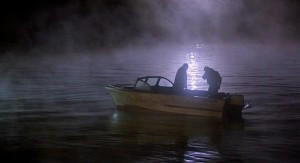 Scene with "Pomp and Circumstance" reference in Tough Guys Don't Dance
Scene with "Pomp and Circumstance" reference in Tough Guys Don't Dance
The film’s ending, where Madeline shoots Regency off-screen and the narrative jumps to the mansion scene, deliberately throws “craft” out the window. This ambiguity and cynicism, Mailer’s commentary on the “American dream,” suggests a world devoid of redemption where “everyone is corrupt from the start.” This jaded perspective aligns with Russ Meyer’s worldview, where characters are not innocent victims but already compromised individuals.
Masculine Females and American Sickness: Thematic Resonance
The “extremely masculine entities” of females in both “Tough Guys Don’t Dance” and Russ Meyer’s films are linked to the war experiences of both filmmakers. This shared background informs the idea of universal corruption and women as “mythical and super-human.” Mailer explicitly conceived Isabella Rossellini’s character as a “masculine woman.”
The film’s “ironic” musical cues further underscore this “American sickness.” This ambiguity between seriousness and camp also mirrors “Blue Velvet.” However, Rosenbaum believes Lynch’s “robin” symbolism and “corrupted innocence” ultimately weaken “Blue Velvet,” while Mailer’s resistance to labeling “Tough Guys Don’t Dance” a comedy might stem from a similar struggle with audience interpretation.
 Blue Velvet Robin scene
Blue Velvet Robin scene
Critical responses to “Tough Guys Don’t Dance” reveal a struggle to classify it, highlighting its genre-defying nature. This resistance to categorization is a key “achievement,” contributing to its “exuberance” and reflecting Mailer’s writing style. The film stands as a rare “transference” of a novelist’s qualities to cinema, deeply connected to Mailer’s written works. Unlike his earlier, more experimental films, “Tough Guys Don’t Dance” engages with Hollywood ideas, evident in its cinematography by John Bailey. While “Maidstone” (1970) may be about mise en scène, “Tough Guys Don’t Dance” actually possesses it, marking a significant step in Mailer’s cinematic evolution.
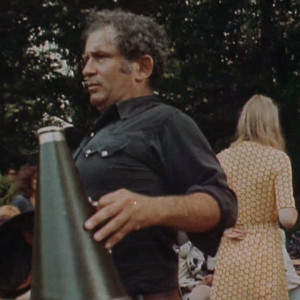 Scene from Maidstone featuring Norman Mailer
Scene from Maidstone featuring Norman Mailer
In conclusion, “Tough Guys Don’t Dance” remains a challenging and rewarding cinematic experience. Its black comedy, baroque style, genre-bending narrative, and exploration of American corruption solidify its status as a cult classic worthy of continued discussion and appreciation.
